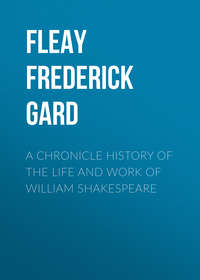Kitabı oku: «A Chronicle History of the Life and Work of William Shakespeare», sayfa 14
TABLES
Table I. – QUARTO EDITIONS OF SHAKESPEARE'S PLAYS.

Table II. – QUARTO EDITIONS OF OTHER PLAYS PERFORMED BY SHAKESPEARE'S COMPANY.

Table III. – NUMBER OF PERFORMANCES AT COURT, 1584-1616.

Table IV. – ENTRIES OF PLAYS IN THE STATIONERS' REGISTERS, 1584-1640.



Table V. – TRANSFERS OF COPYRIGHT IN PLAYS, 1584-1640.

At this point we lose the aid of Mr. Arber's reprint of "The Stationers' Registers," which does not extend beyond 1640. It is, however, necessary to continue our notes to 1660, the date of the reopening of the theatres, because even at that date entries were made attributing plays to Shakespeare. The following memoranda have no pretence to completeness, and are compiled (pending an opportunity of examining the registers themselves) from the much-abused Biographia Dramatica, which is, nevertheless, much more useful than the abbreviated compilation made from it (retaining nearly all its errors) by the scissors of Mr. Halliwell, and published by him as A Dictionary of Old English Plays. Two of these entries are so important for dramatic history that they are printed in parallel columns, with the list of MSS. once in the possession of John Warburton, the Somerset Herald, but mostly destroyed by his cook. From these it will be seen at a glance that three-fifths of his collection consisted of the remainder of Moseley's stock, which contained the majority of old unprinted MSS. extant in 1660.
From these S. R. entries, taken as a whole, the reader will find that the total number of extant plays originally produced between 1576, when theatres were first opened, and their closing in 1642, is less than 500. Nor have we reason to believe that they ever numbered more than 2000 or so. Nearly all worth preserving has been preserved. The gross exaggerations of Halliwell and Collier on this matter depend on their estimating the number of contemporaneous theatres and companies at some fifteen. They really never exceeded five. They also neglect the facts that many so-called new plays were mere revisions of the old ones, "new vamped" versions slightly altered; and that the inferior theatres depended largely on extemporaneous performances, of which only the plots were committed to writing. In the palmy days of the Admiral's company, Henslow brought out a new play once a fortnight, but this was undoubtedly an exceptional instance. The best companies, such as the King's, and after them the Queen's, produced one in about two months. Taking all this into consideration, 2000 is a liberal estimate; 20,000 is a number that could only be dreamed of by an inaccurate writer intent on effect rather than truth. And of this 2000 not more than a quarter would be worth preserving: indeed, of those preserved many are quite valueless. The few good ones lost are such as The Jeweller of Amsterdam, suppressed for political reasons; or the original Henry VIII., destroyed by fire or other accident.
In these Supplementary Lists names of authors wrongly attributed are printed in italics, and names of plays occurring both in Warburton's list and Moseley's entries are asterised.
1646. Sept. 4, were entered, The Spartan Ladies, by Ludovic Carlell; The Corporal and the Switzer, by Arthur Wilson; The Fatal Friendship, by Burroughes.
1653. Sept. 23, The Bondwoman.
1653. Nov. 29 (by R. Marriot), The Black Wedding; Castara, or Cruelty without Lust; The Conceits; The Divorce; The Florentine Friend; A Fool and her Maindenhead soon parted; The Law Case; The Noble Ravishers; The Paraside, or Revenge for Honor, by Henry Glapthorne; Pity the Maids; The Proxy, or Love's Aftergame; The Royal Choice, by Sir Robert Stapylton; Salisbury Plain; Supposed Inconstancy; The Woman's Law; Woman's Masterpiece; The Younger Brother.
1654. April 8, The Apprentice's Prize, by Brome and Heywood; The Life and Death of Sir Martin Skink, with the Wars of the Low Countries, by Brome and Heywood; The Jeweller of Amsterdam, or the Hague, by Fletcher, Field, and Massinger; The Maiden's Holiday, by Marlowe and Day (see Warburton's list).
SUPPLEMENTARY TABLE OF MOSELEY'S ENTRIES IN 1653 AND 1660, AND WARBURTON'S LIST.

NOTE ON THE ETCHINGS
I have been asked to say a few words on the illustrations to this volume. The Portrait of Alleyn has been kindly permitted to be taken from the oil painting preserved at Dulwich College, and has not, it is believed, been previously engraved as a book illustration. It was thought that the reader would prefer a representation of this great actor, the first managing director under whom Shakespeare performed, to a reproduction of one of the many portraits of the poet himself, which have now become so hackneyed. For like reason, the Font in which Shakespeare was baptized has been obtained from a hitherto unreproduced original: an oil sketch made on the spot in 1853 by the world-known painter, Mr. Henry Wallis, and now in the artist's possession. It is with no little satisfaction that I find my work allowed to be associated with that of a painter so eminent, and with the name of one of the great poets for all ages, Mr. Robert Browning.
